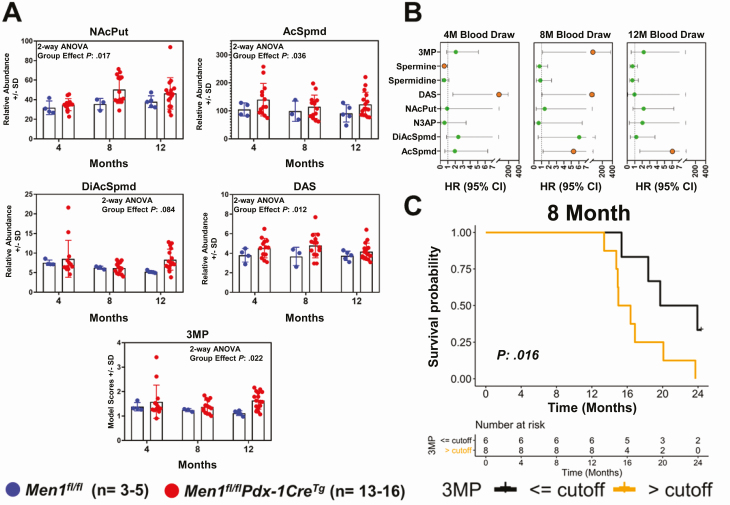Figure 3.
Association between plasma polyamines and disease progression in a mouse model of multiple endocrine neoplasia type 1–pancreatic neuroendocrine tumor (MEN1-pNET). A, Scatter plots illustrating relative abundance (area units ± SD) of plasma polyamines N-acetylputrescine (NAcPut), acetylspermidine (AcSpmd), diacetylspermidine (DiAcSpmd), diacetylspermine (DAS), and the polyamine signature at 4-, 8-, and 12-month blood collection time points in Men1fl/flPdx1-CreTg mice and littermate (Men1fl/fl) controls. The 3-marker plasma polyamine signature (3MP) consisting of AcSpmd + DiAcSpmd + NAcPut was developed in the human cohort of patients with MEN1 and applied, using fixed coefficients, to the MEN1-pNET mouse model. Statistical significance was determined by 2-way analysis of variance (ANOVA); 1-sided P values for group effect (Men1fl/flPdx1-CreTg/Men1fl/fl status) are reported. B, Time-dependent hazard ratios (HR; 95% CI) per unit log2 increase in relative abundance (area units) of individual polyamines as well as the 3MP for association with overall survival. Orange nodes indicate statistical significance (1-sided P < .05) C, Kaplan-Meier survival curve illustrating association between plasma polyamine signature scores at the 8-month blood collection time point and overall survival in Men1fl/flPdx1-CreTg mice. High (> cutoff; orange line) and low (≤ cutoff; black line) levels of the polyamine signature were defined based on an optimal changepoint value–derived log rank test statistics-based method as described by Contal and O’Quigley (24). Statistical significance between survival curves was determined by 1-sided log-rank (Mantel-Cox) test.

